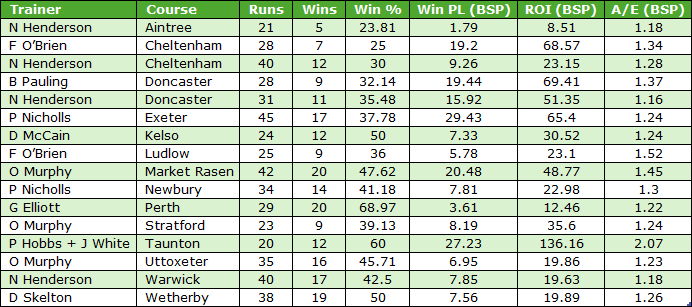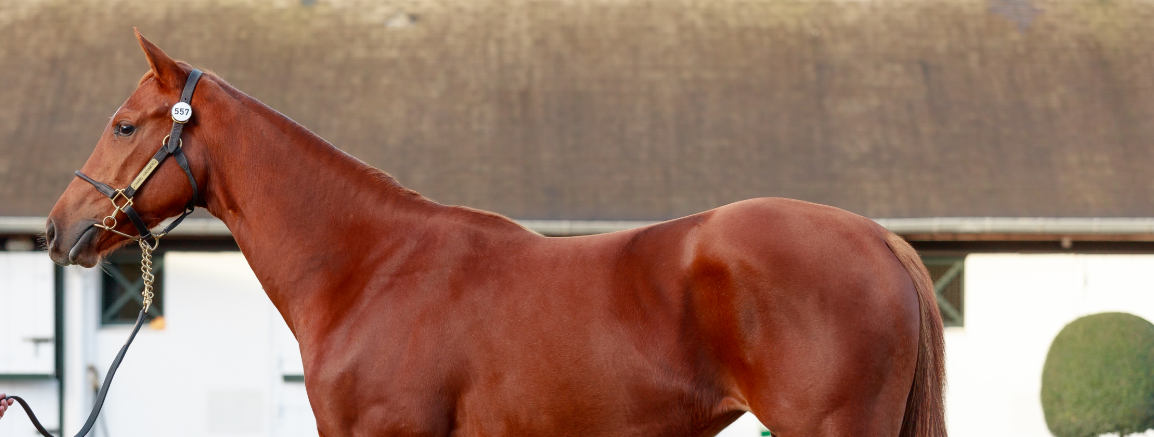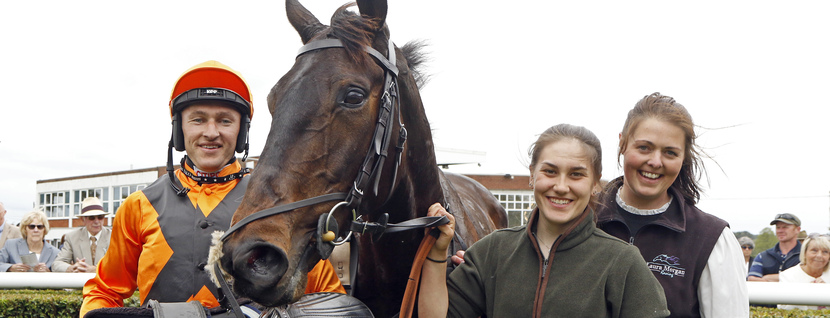Preparing for the jumps – Part 1, Novice Hurdles
The days are getting shorter, the nights are getting longer, which means the National Hunt season is beginning to click into gear, writes Dave Renham. October has 51 scheduled meetings in the UK over jumps, more than double the number in September. I will be writing a series of six articles over the coming weeks that share statistics, both positive and negative, that I hope we can use to our advantage this season.
Contents
ToggleIntroduction
In this first piece I am going to concentrate on novice hurdle races, with data taken from 1st January 2018 to 31st August 2025, a period of a little over seven and a half years. Profits and losses have been calculated using Betfair Starting Price (BSP) with a 2% commission applied on any winning bets.
Novice hurdle races can be either handicap or non-handicap contests, and as there are roughly treble the number of non-handicaps, my focus is on this bigger group. Let me start by looking at market factors for all non-handicap novice hurdle races.
Market factors
I will use Betfair's market rank, which may occasionally be slightly different from the industry SP rank - though such differences are unlikely to materially impact any discernible patterns. I will start by sharing the results for the ‘value’ metric, the A/E index. These indices are based on BSP prices and the splits are as follows:
Third and fourth favourites offered the best value. Is that replicated when studying a wider array of metrics?
Third favourites performed the best from a profit/loss perspective, while fourth favourites essentially broke even, so the A/E indices were a good guide in terms of value. Meanwhile, favourites won roughly half of all these races but despite that dominance they made a small loss overall. Those sent off fifth market rank or lower on Betfair did extremely poorly, losing over 34p in the £.
Returning to favourites, horses aged five and six provided around 75% of all favourites, and those runners virtually broke even if backing all of them blind – 1293 wins from 2513 (SR 51.5%) for a minimal loss of £5.67 (ROI -0.2%); A/E (BSP) 1.01. There were some positive angles for favourites, but due to the short prices on offer it is difficult to produce significant returns.
Here are a few:
I will analyse trainers in greater detail below, but it seems that Gordon Elliott should be noted when saddling a favourite in non-handicap novice hurdle races.
Having looked at the market, it is time to move on to other areas. However, I have imposed a BSP price limit of 20.0 or lower from now on, to avoid any winners at excessively big odds potentially skewing the bottom line.
Sex of horse
Is there any difference between the performance of male horses versus female ones? There are three times as many male runners when it comes to non-handicap novice hurdles, so more races are won by males of course. However, was there a difference in the respective win strike rates using the BSP 20.0 or lower limit?
Males outperformed females by around 2.4% in absolute win percentage terms, which equates to a differential of just over 10%. That also translated to a marginally better bottom line:
As we can see, male runners broke even during the review period while female runners lost us just over two pence in the £. There was not too much in it overall but, in general terms, male runners were slightly better betting propositions than females over the period of study.
Age
A look at the age of horses racing in non-handicap novice hurdles next. There were only 15 three-year-old qualifiers since 2018 - that age group almost exclusively running in juvenile races - so I have ignored those. Here are the splits for four-year-olds and up:
It is interesting that the general trend in terms of win strike rate was the older the better, which is unusual in most race types across both flat and NH. Not only that but the best value was also with older horses. Those aged six and up recorded solid overall profits. Sticking with the aged six and older group, if we restrict races to shorter distances (2m 1f or less) their record improved further:
Returns approached 13p in the £ and this cohort secured a positive return (ROI%) in seven of the eight years as the graph below shows:
The only losing year has been this current year, 2025, but losses are small and there is still plenty of time to edge back into profit.
Previous hurdle runs
My next port of call looks at the number of hurdles races each runner had previously had. The findings surprised me a little:
The more experience over hurdles a horse boasted the better the win percentage. This perhaps correlates well with the age stats displayed earlier although it doesn't necessarily follow that an older horse is a more experienced one.
The most successful group in monetary terms were those making their debut over hurdles. These runners secured a profit of over £260 to £1 level stakes, equating to returns in excess of 10p in the £.
Perhaps not surprisingly based on previous findings, hurdle debutants aged six-plus was a strong angle: 116 wins from 560 runners (SR 20.7%) for a profit of £138.24 (ROI +24.7%); A/E (BSP) 1.12. It could be argued that this is back-fitting, but nevertheless the results catch the eye.
Last time out (LTO) Race type
What about LTO Race type? Is there anything to glean from these stats? Let us see:
The vast majority of runners ran in a hurdle race last time, which is to be expected, but it is the last day NH Flat figures that stand out with a near 9% ROI. If we further restricted those LTO NHF qualifiers to horses that finished in the first five on that prior spin, results improved to 258 wins from 1132 runs (SR 22.8%) for a profit of £156.87 (ROI +13.9%); A/E (BSP) 1.05.
Trainers
Different trainers target different types of races, and of course the quality of horses within their stables differs massively. That has a bearing on the handlers who appear in this section, others performing to better effect further down the line in handicap company.
Below is a table outlining individual trainer data in novice hurdles during the period of study with the 20.0 BSP price cap. To qualify a trainer must have had at least 90 such runners:
13 of the 32 trainers made a blind profit, with Lucinda Russell’s figures particularly impressive (returns of over 39p in the £). She had an excellent record at Ayr with 11 wins from 34 (SR 32.4%) for a healthy profit of £38.87 (ROI +114.3%). She also made decent profits at Newcastle (6 wins from 16) and Carlisle (7 wins from 19) – each with returns in excess of 100%.
In contrast the O’Neill and Pipe stables have performed relatively poorly, showing significant losses.
Previous hurdle runs by trainer
I would like to expand my trainer research a little by looking at the performance of trainers' runners in relation to the number of previous races they had had over hurdles. Firstly, let me compare win strike rates:
We saw earlier that, in terms of win percentage, the more exoerience the better over hurdles; but as far as individual trainers are concerned there are not too many that conform to that pattern. Lucinda Russell, for example, saw her strike rate drop as her runners gained more experience over hurdles. Her record with hurdling debutants was excellent – a strike rate of 30.9% thanks to 17 wins from 55 for a profit of £48.56 (ROI +88.3%); A/E (BSP) 1.53.
The stables of Alan King and the Moores also fared particularly well with hurdle debutants although both had fewer qualifiers in the past year or two.
At the other end of the scale was Ben Pauling whose hurdle debutants struggled overall, scoring less than 9% of the time and incurring losses of over 65p in the £. Likewise, Warren Greatrex runners in such races improved steadily from a low (9.68%) novice hurdle debut strike rate.
Trainers to note with horses having their second run over hurdles were Donald McCain and Jamie Snowden. McCain’s 33 wins from 94 (SR 35.1%) notched a profit of £17.93 (ROI +19.1%), A/E (BSP) 1.25; while Snowden’s 16 wins from 39 (SR 41%) was worth £8.27 (ROI +21.1%); A/E (BSP) 1.20.
In terms of the more experienced hurdlers, Kim Bailey's team did well when they'd had at least three previous runs (the 4+ group). His record in that context reads 19 wins from 46 (SR 41.3%) for a healthy profit of £16.73 (ROI +36.4%); A/E (BSP) 1.26. Fergal O’Brien also performed well with these experienced runners, securing 64 wins from 169 (SR 37.9%) and a profit of £31.28 (ROI +18.5%); A/E (BSP) 1.17.
Let me build on that and share a comparison of A/E (BSP) indices. For this table I have highlighted the most positive indices (in blue) and the poorest ones (in red):
Nigel (now assisted by Willy) Twiston-Davies earns a mention as the only trainer to have managed an A/E index above 1.00 across all four groups. The Hobbs/White yard were close with three 1.00+ figures and a 0.98, as was Kim Bailey whose only figure below 1.00 was 0.99. Not surprisingly I guess, all three of these stables made a blind profit with their novice hurdlers as can be seen in the earlier table.
Onto my final piece of digging, which is...
Trainers and courses
Have any trainers excelled at specific course with their novice hurdlers? These were the strongest combinations ordered by course (20 runs minimum to qualify):
All 16 combinations proved profitable, with the Hobbs/White performance at Taunton particularly impressive. Long may it continue!
**
I hope this opening salvo for the National Hunt has highlighted some interesting angles for non-handicap novice hurdles. I'll be back next week with Part 2, looking at the novice chase division.
Until then...
- DR





























Hi Dave, Thanks for all of your work.
It would be interesting to know, though probably impossible to elicit due to lack of records, which areas the succesfull runners have been involved in prior to their Novice Hurdle career.
It was a lot easier years ago when most came off the Flat, whereby now, it is largely unexposed types, especially relating to the horses first few runs in Novice Hurdles. I find I have to wait until around January before getting a handle on anything.
Irish PtP’s
GB PtP’s.
Flat Turf/AW.
Bumpers
France.
Yes it is difficult to get that sort of data, especially point to point data. Certainly would be interesting to know!
as always gd read Dave partitulary in strike rate 1st 4 runs in nov hurdles. is there any chance of stats for trainers in oct,nov and dec with s/r over 25% and price under 10/1. cant wait for the chasers in part 2.
Absolute gem of a starting point for the real
looking forward to further pointers and stats
Thank you very much Dave
Hi Dave, thanks for this, very informative as usual, trainers and courses is my thing. Do you have any stats regarding horses carrying penalties for winning a Novice Hurdle? I will often oppose them as they go off at prohibitive odds, especially those carrying a double penalty.
Qualifiers are quite rare in terms of horses that ran in a novice hurdle LTO and are carrying a penalty this time. Only around 14 qualifiers per year on average but they would have lost 17p in the £ which is steep. I guess most trainers are not keen to turn their runners out so quickly, especially relatively inexperienced hurdlers.
Leave a Reply
Want to join the discussion?Feel free to contribute!